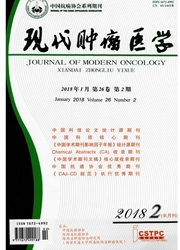

 中文摘要:
中文摘要:
目的:全面考察我们前期工作中采用mPEG-PCL自行合成的汉防己甲素(Tetradrine,Tet)载药纳米微球的体外抗肿瘤活性,并对其机理进行探讨,并评价mPEG-PCL作为药物载体的生物相容性。方法:通过开环聚合法,制备mPEG-PCL两嵌段聚合物作为载体,采用乳化-挥发法,制备负载Tet的纳米微球。以MTT法,评价该纳米微球在体外对于胃癌细胞株MKN-28、BGC-823的抗肿瘤活性,并与汉防己甲素裸药相比较。在MKN-28、BGC-823及LO2细胞株上验证空白微球的毒性。采用荧光标记粒子细胞摄取实验,探讨Tet纳米微球抗肿瘤作用不同于裸药的机制。结果:Tet载药微球在作用48h后对于体外培养的肿瘤细胞生长的抑制率与裸药相似,空白微球在极高浓度时,对于肿瘤细胞系及人肝细胞株LO2均无明显毒性。荧光标记粒子的细胞摄取实验证实,微球可通过胞吞作用进入细胞,在细胞内释放药物,这是微球不同于裸药的抗肿瘤机制。结论:Tet微球具有良好的抗肿瘤活性,载体无毒,具有良好的生物相容性。其抗肿瘤作用的机制可能和细胞对于纳米粒子的直接摄取有关,因此可能提高汉防己甲素的体内抗肿瘤效果。
 英文摘要:
英文摘要:
Objective:to prepare tetradrine (Tet) -loaded nanoparticles with bi -block copolymer mPEG -PCL, and evaluate their in vitro antitumor effects and the possible mechanism, the biocompatibility of mPEG - PCL was also studied. Methods : mPEG - PCL was synthesized by ring - opening polymerization method and the nanoparticles were prepared by o/w emulsion method. The in vitro cytotoxicity of Tet - loaded nanopartieles and toxicity of the blank nan- oparticles were evaluated by MTT assay on MKN - 28, BGC - 823 and LO2 cells. We also studied the mechanism of the nanoparticles by cellular uptade studies. Results: Tet - loaded nanoparticles exhibited similar in vitro antitumor effect compared to free Tet. The blank nanoparticles was non - toxic to all the tumor cell lines as well as LO2 cells. In the cellular uptake studies, it was found that the nanoparticles can enter cells via endocytosis, which was different from free drugs. Conclusion:Tet - loaded nanoparticles exhibited preferable antitumor effect. The copolymer was of good biocompatibility. The nanoparticles exhibited antitumor effect via endocytosis. We will further evaluate the antitumor effect of the nanopaticles in vivo.
 同期刊论文项目
同期刊论文项目
 同项目期刊论文
同项目期刊论文
 Gambogic acid, a potent inhibitor of survivin, reverses docetaxel resistance in gastric cancer cells
Gambogic acid, a potent inhibitor of survivin, reverses docetaxel resistance in gastric cancer cells Enhanced efficiency of thermally targeted taxanes delivery in a human xenograft model of gastric can
Enhanced efficiency of thermally targeted taxanes delivery in a human xenograft model of gastric can 期刊信息
期刊信息
